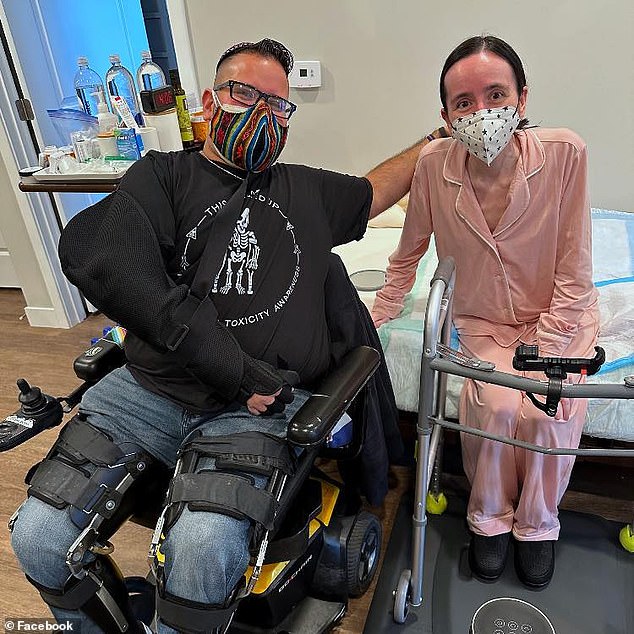A New England man has revealed how a common antibiotic left him disabled and going blind.
Mateo Rodriguez is one of tens of thousands of Americans left with life-changing injuries after taking a group of antibiotics called fluoroquinolones.
At age 22, he went to doctors with a urinary tract infection, an infection of the bladder or tubes that carry urine from the body, and was prescribed ciprofloxacin, brand name Cipro or Proquin XR.
But after taking just a few pills, he started to suffer from reactions that made him feel like a ‘bomb went off in my body’.
Bumps exploded all over his arms, he started to suffer from severe pain, and struggle to use his legs — leaving him needing to use braces and a wheelchair.
Rodriguez suffered what victims call being ‘floxed’, a rare adverse reaction where patients suffer damage to nerves and tendons from a fluoroquinolone antibiotic.
The nerves in his eyes have also been partially eroded, meaning Rodriguez needs to wear specialist glasses to protect his eyes from further damage.
That was in September 2017. Seven years on, Rodriguez says he is doing well — but still needs a wheelchair, leg braces to get around.
He is also going blind, so he wears special glasses and uses a cane to keep from falling, he told Drugwatch in 2019.


Yet despite his and other patients going public with similar harrowing experiences, physicians are still prescribing the drug to 2million people are still prescribed the drug every year.
The FDA has added three black box warnings to the prescription label for the drug since 2008, its highest level warning, and says it has received about 60,000 reports of patients suffering harm while on the medication since the 1980s.
Rodriguez, who is also trans, said he remembered at the time he got the prescription that the pharmacist warned him about the drug, but said he would be fine because he wasn’t over 65 years old.
Rodriguez told Drugwatch: ‘I remember my exact words [to the pharmacist] were, “Oh, yeah, I’m sure it’s very rare so I’m not worried about it”.
‘And within two weeks, I automatically started feeling like a bomb went off in my body.’
Within days of taking the drug, however, the bumps on his arm were diagnosed as tendinitis — or when a tendon swells and becomes inflamed.
And within a month, he was also diagnosed with peripheral neuropathy — where nerves outside the brain are damaged, causing tingling, numb and burning sensations — rheumatoid arthritis and fibromyalgia — a diagnosis of last resort for general pain in the body.

From October this year, the CDC will formally recognize fluoroquinolone toxicity syndrome and issue a diagnosis code for the condition.
This means that patients will finally be able to get treatment, and to bill their insurers for care.
Rodriguez has been left struggling after the diagnosis, and feeling as though his life was turned upside down.
The antibiotic’s effects and being disabled took a toll on his mental health, with Rodriguez suffering from psychosis — detachment from reality — and two suicide attempts.
‘I had a psychotic episode where I thought that the government was reading my mind,’ he said.
‘I thought, well, they can’t read my brain if I stick my head in the oven and melt my brain. Thank goodness my roommate walked in on it, and I had to go to the hospital right then.’
Rodriguez has now found work with a home for disabled people, helping to tutor others to find a job.
He still needs braces and a wheelchair seven years after taking the antibiotic, but is regularly pictured smiling on social media and living life to the fullest.
He also regularly posts about the risks of ciprofloxacin to warn others, and on October 22, he celebrated Fluoroquinolone Toxicity Awareness day.

Doctors say ciprofloxacin can cause tendinitis because the antibiotic can interfere with the construction of collagen, a key component of tendons, and inhibit its repair. Tendons are strong and fibrous connective tissue that attach muscle to bones.
Some also suggest that the drug can damage mitochondria, reducing the amount of energy they produce and disrupting the normal functioning of cells. This may be behind the neuropathy that some patients have experienced after taking the drug.
It isn’t clear how many people suffer from life-altering reactions like Rodriguez’s, but the UK’s health agency estimates one in ten people have a reaction.
In many cases, these are mild and ease soon after someone discontinues the drug, with the most common being nausea, diarrhea, vomiting and a rash.
But there are also rare cases of people suffering from disabling reactions after using the drug.
Dr Mark Ghalili, a physician in Los Angeles, used to prescribe the antibiotic to patients before he suffered a severe reaction to it himself — which left him with difficulty walking for months.
He told DailyMail.com: ‘I used to use these antibiotics on a daily basis in hospitals and the ICU [back in 2016], it was only later that I realized these could have harmed patients’ health or made their recovery stretch into months.
‘Now I refuse to prescribe it. I wouldn’t prescribe it if there was a gun to my head or if someone paid me all the money in the world.
‘Of all the thousands of people that I have helped with fluoroquinolone toxicity, never once have I seen a patient [tested to ensure their infection can be treated with these antibiotics.’
Studies suggest that about one in five bacterial infections are now resistant to this antibiotic, which studies suggest can damage the human body.
The FDA has urged prescribers not to prescribe for general infections because of the side effects, and the UK’s health agency has told doctors to use the drug as a last resort only.
